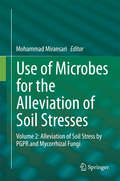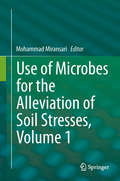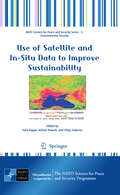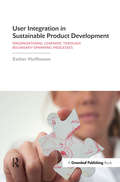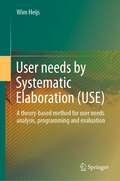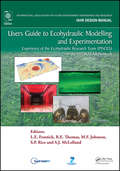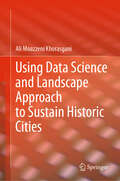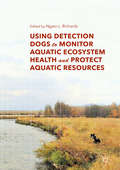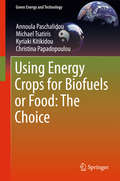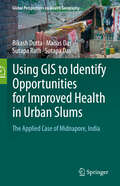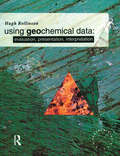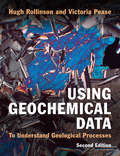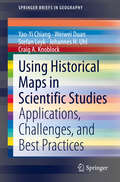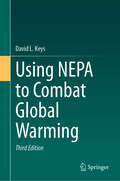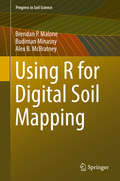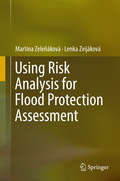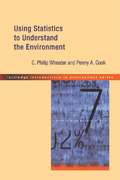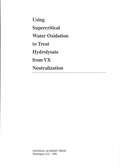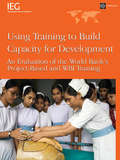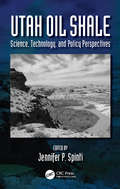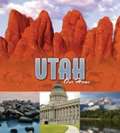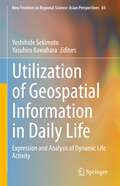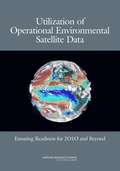- Table View
- List View
Use of Microbes for the Alleviation of Soil Stresses
by Mohammad MiransariUse of Microbes for the Alleviation of Soil Stresses, Volume 2: Alleviation of Soil Stress by PGPR and Mycorrhizal Fungi describes the most important details and advances related to the alleviation of soil stresses by PGPR and mycorrhizal fungi. Comprised of eleven chapters, the book reviews the role of arbuscular mycorrhizal fungi in alleviation of salt stress, the role of AM fungi in alleviating drought stress in plants, the impact of biotic and abiotic stressors and the use of mycorrhizal fungi to alleviate compaction stress on plant growth. Written by experts in their respective fields, Use of Microbes for the Alleviation of Soil Stresses, Volume 2: Alleviation of Soil Stress by PGPR and Mycorrhizal Fungi is a comprehensive and valuable resource for researchers and students interested in the field of microbiology and soil stresses.
Use of Microbes for the Alleviation of Soil Stresses, Volume 1
by Mohammad MiransariUse of Microbes for the Alleviation of Soil Stresses, Volume 1 describes the most important details and advances related to the alleviation of soil stresses by soil microbes. Comprised of seven chapters, the book reviews the mechanisms by which plant growth promoting rhizobacteria (PGPR) alleviate plant growth under stress; the role of mycorrhizal fungi on the alleviation of drought stress in host plants; how PGPR may alleviate salinity stress on the growth of host plants; and the role of PGPR on the growth of the host plant under the stress of sub optimal root zone temperature. Written by experts in their respective fields, Use of Microbes for the Alleviation of Soil Stresses, Volume 1 is a comprehensive and valuable resource for researchers and students interested in the field of microbiology and soil stresses.
Use of Satellite and In-Situ Data to Improve Sustainability
by Alfred Powell Felix Kogan Oleg FedorovMore than 30-year operational satellite data have already been used for monitoring land, ocean and atmosphere. These applications have contributed to improve sustainable economy, produce healthy environment and enhance human life. The Advanced Research Workshop sponsored by NATO and organized by the USA's National Oceanic and Atmospheric Administration and Ukrainian's Space Agency bring the scientists with the most mature research designed for practical use. The goals were to select those which is used for services today and identify the areas to expand research and services. Scientific and application results of the Workshop presented in this book can be used today in agriculture, forestry, water resources, healthy coastal life and fisheries, climate and land cover change, anthropogenic activities and others. The presented papers provide information on how to use operational satellites and in situ measurements for early detection of large-scale droughts, floods and fires, diagnose crop and pasture annual losses, predict periods with health/unhealthy vegetation based on such climate forcing events as ENSO, monitor air quality and geomagnetic activities, assess land cover trends in responce to global warming etc. The available satellite/ground information and method is currently warn with a lead time sufficient to respond, recover and protect.
User Integration in Sustainable Product Development: Organisational Learning through Boundary-Spanning Processes
by Esther HoffmannChanges in production and consumption patterns are a crucial element in advancing the sustainability agenda. Many companies are now contributing to such efforts through a focus on sustainable innovation when developing new products and services. However, problematically, many such products fail as consumers reject them in the marketplace. User integration in product development is a well-suited approach to increase the usability and the marketability of new products. This book asks the following question: under what conditions can companies trigger sustainability-oriented organizational learning processes by integrating consumers in product development? The author analyses this question by studying a new approach called INNOCOPE (Innovating through consumer-integrated product development). The analysis is based on a process model of organizational learning, distinguishing different learning phases and related boundary-spanning activities. The case study shows that boundary spanning and communication with external actors may directly affect almost all phases of the organizational learning process. Depending on the organizational learning phase, specific boundary-spanning activities are identified that can be characterized as outside-in, inside-in or inside-out directed processes. Moreover, the book describes supportive conditions for user integration with regard to the company, the product, the users involved and the communication process, and provides managerial recommendations. User Integration in Sustainable Product Development sheds new light on the interaction between companies and users in innovation processes and how they relate to sustainable product development. Its focus on organizational learning at and across the boundaries of companies is original, stimulating, improves our understanding of user–producer interactions and distinguishes the book from other publications on the market. The book provides a hugely comprehensive overview of user integration in innovation processes: its advantages, problems and weaknesses, and the methods in which it is currently applied. This, along with a systematic analysis of organisational learning provides the reader with a complete understanding of what has to be considered when studying user-producer interactions from a company perspective and provides the basis for further improvements and company strategies to advance the take-up of sustainable products. The book will be essential reading for academics and practitioners involved with organizational learning, innovation studies, sustainable design and product development, and marketing.
User needs by Systematic Elaboration (USE): A theory-based method for user needs analysis, programming and evaluation
by Wim HeijsThe design of a building can facilitate the process of use and promote the well-being of users if it meets their needs. Knowledge of user needs and processes of use is important for a good design. However, it is not self-evident what user needs really are, how user needs and processes of use can be researched, and how that knowledge can be used in a design. This book introduces an integrated methodology for the analysis of user needs, programming and evaluation that answers these questions. The purpose is to improve the interaction between the users and their environment and to avoid failure costs by facilitating proper design decisions. The theoretical perspective and the conceptual framework originate from environmental psychology, more specifically P-E fit theory. The target group consists of those who are interested in creating environments for people (designers, users, real estate managers; students and scientific staff). Designers are a special audience for whom the book can be a guide to working for and with users. The theoretical perspective and the conceptual framework can also be relevant for scientific research into the interaction between users and buildings.
Users Guide to Ecohydraulic Modelling and Experimentation: Experience of the Ecohydraulic Research Team (PISCES) of the HYDRALAB Network (IAHR Design Manual)
by L. E. Frostick S. J. McLelland R. E. Thomas M. F. Johnson S. P. RiceUsers Guide to Ecohydraulic Modelling and Experimentation has been compiled by the interdisciplinary team of expert ecologists, geomorphologists, sedimentologists, hydraulicists and engineers involved in HYDRALAB IV, the European Integrated Infrastructure Initiative on hydraulic experimentation which forms part of the European Community‘s Seventh F
Using Data Science and Landscape Approach to Sustain Historic Cities
by Ali Moazzeni KhorasganiThis book comprehensively explores sustaining historic cities using a landscape approach and data science. The author offers valuable insights for professionals and enthusiasts interested in preserving and developing urban heritage through a data driven approach. Drawing on the synergy between landscape architecture and data science, the book delves into the intricate interplay between historical, cultural, and environmental factors in urban settings. Readers will understand how to navigate historic cities' complex challenges through case studies, research findings, and practical methodologies. The book equips readers with innovative strategies for preserving the authenticity of these cities while embracing sustainable development practices. By blending theory and real-world applications, this book is a comprehensive guide for creating thriving, resilient, and culturally rich urban environments.
Using Detection Dogs to Monitor Aquatic Ecosystem Health and Protect Aquatic Resources
by Ngaio L. RichardsThis book is about the varied range of emerging applications using specially trained detection dogs to monitor and protect aquatic ecosystems, animals, plants and related resources. Featuring contributions from those at the forefront of converging disciplines ranging from canine training, ecological and biological monitoring, water resource management, law enforcement, and eco-toxicology, it addresses everyone already immersed in these or related fields, and anyone seeking to gain a broader understanding of them. Chapters cover several common themes including monitoring presence/absence through biological and ecological surveys; maintaining and evaluating water quality; law enforcement and anti-poaching initiatives; public education, awareness and compliance; standards and best practices; optimal uses of dogs in relation to and in conjunction with other available tools and pragmatic considerations for selecting and working with dogs and handlers. The aim of the book is to stimulate new ideas, promote the sharing and dissemination of information and findings - and, ideally, to catalyze new and innovative partnerships, to strengthen the preservation and conservation of our aquatic heritage.
Using Energy Crops for Biofuels or Food: The Choice (Green Energy and Technology)
by Annoula Paschalidou Michael Tsatiris Kyriaki Kitikidou Christina PapadopoulouThis book performs a SWOT (strengths, weaknesses, opportunities and threats) analysis to examine the current food crisis and how it relates to the use of crops for energy. It analyses how energy crops may help solve humankind’s environmental changes and summarises the economic and practical changes of cultivating and utilising energy crops. Two of humanity’s greatest challenges are the need for more food production as well as growing demands for energy. Biofuel cultivation has been identified as a solution to growing energy use, and biomass power plants offer a rare renewable energy source that requires only basic technology.In this context, a dilemma arises concerning whether energy crops should be used for energy or to help remedy the food crisis. SWOT analysis allows us to organise and weigh different pros and cons against each other in terms of economics, job creation, environmental impacts, the climate change agenda, and European Union (EU) directives that promote biofuels over fossil fuels. By pursuing this approach, the book helps researchers and decision-makers cut through the many competing arguments in connection with this complex subject.
Using GIS to Identify Opportunities for Improved Health in Urban Slums: The Applied Case of Midnapore, India (Global Perspectives on Health Geography)
by Bikash Dutta Manas Das Sutapa Rath Sutapa DasThis book offers geospatial modelling techniques for the analysis of healthcare in poor urban neighborhoods and of the ways that residents of these neighborhoods make healthcare choices and cope with deprivation. The authors use the case of Midnapore, India to explore the overall health infrastructure and the perceptions of residents of urban slums regarding the provision, utilization, and accessibility of the healthcare system through the application of geostatistics and geospatial techniques and modelling, with an eye towards reducing inequalities. The study described here can be used as a model for researchers, planners, NGOs, policymakers and government authorities to conduct similar analysis of other low-income urban neighborhoods. Also, this book may assist students in understanding the basic tools and techniques of applying GIS tools to study social problems.
Using Geochemical Data: Evaluation, Presentation, Interpretation (Longman Geochemistry Series)
by Hugh R. RollinsonUsing Geochemical Data brings together in one volume a wide range of ideas and methods currently used in geochemistry, providing a foundation of knowledge from which the reader can interpret, evaluate and present geochemical data.
Using Geochemical Data: To Understand Geological Processes (Longman Geochemistry Ser.)
by Hugh Rollinson Victoria PeaseThis textbook is a complete rewrite, and expansion of Hugh Rollinson's highly successful 1993 book Using Geochemical Data: Evaluation, Presentation, Interpretation. Rollinson and Pease's new book covers the explosion in geochemical thinking over the past three decades, as new instruments and techniques have come online. It provides a comprehensive overview of how modern geochemical data are used in the understanding of geological and petrological processes. It covers major element, trace element, and radiogenic and stable isotope geochemistry. It explains the potential of many geochemical techniques, provides examples of their application, and emphasizes how to interpret the resulting data. Additional topics covered include the critical statistical analysis of geochemical data, current geochemical techniques, effective display of geochemical data, and the application of data in problem solving and identifying petrogenetic processes within a geological context. It will be invaluable for all graduate students, researchers, and professionals using geochemical techniques.
Using Historical Maps in Scientific Studies: Applications, Challenges, and Best Practices (SpringerBriefs in Geography)
by Yao-Yi Chiang Weiwei Duan Stefan Leyk Johannes H. Uhl Craig A. KnoblockThis book illustrates the first connection between the map user community and the developers of digital map processing technologies by providing several applications, challenges, and best practices in working with historical maps. After the introduction chapter, in this book, Chapter 2 presents a variety of existing applications of historical maps to demonstrate varying needs for processing historical maps in scientific studies (e.g., thousands of historical maps from a map series vs. a few historical maps from various publishers and with different cartographic styles). Chapter 2 also describes case studies introducing typical types of semi-automatic and automatic digital map processing technologies. The case studies showcase the strengths and weaknesses of semi-automatic and automatic approaches by testing them in a symbol recognition task on the same scanned map. Chapter 3 presents the technical challenges and trends in building a map processing, modeling, linking, and publishing framework. The framework will enable querying historical map collections as a unified and structured spatiotemporal source in which individual geographic phenomena (extracted from maps) are modeled (described) with semantic descriptions and linked to other data sources (e.g., DBpedia, a structured version of Wikipedia). Chapter 4 dives into the recent advancement in deep learning technologies and their applications on digital map processing. The chapter reviews existing deep learning models for their capabilities on geographic feature extraction from historical maps and compares different types of training strategies. A comprehensive experiment is described to compare different models and their performance.Historical maps are fascinating to look at and contain valuable retrospective place information difficult to find elsewhere. However, the full potential of historical maps has not been realized because the users of scanned historical maps and the developers of digital map processing technologies are from a wide range of disciplines and often work in silos. Each chapter in this book can be read individually, but the order of chapters in this book helps the reader to first understand the “product requirements” of a successful digital map processing system, then review the existing challenges and technologies, and finally follow the more recent trend of deep learning applications for processing historical maps. The primary audience for this book includes scientists and researchers whose work requires long-term historical geographic data as well as librarians. The secondary audience includes anyone who loves maps!
Using Mathematica for Quantum Mechanics: A Student’s Manual
by Roman SchmiedThis book revisits many of the problems encountered in introductory quantum mechanics, focusing on computer implementations for finding and visualizing analytical and numerical solutions. It subsequently uses these implementations as building blocks to solve more complex problems, such as coherent laser-driven dynamics in the Rubidium hyperfine structure or the Rashba interaction of an electron moving in 2D. The simulations are highlighted using the programming language Mathematica. No prior knowledge of Mathematica is needed; alternatives, such as Matlab, Python, or Maple, can also be used.
Using NEPA to Combat Global Warming
by David L. KeysThis book will help policy makers, university students, and the general public understand how the National Environmental Policy Act (NEPA) is intended to work, and how it can be used to reduce greenhouse gas (GHG) emissions in order to combat global warming. Unlike all other books on NEPA, this book focuses on the global warming problem in terms of thermodynamics and entropy. It explains how NEPA can help combat global warming by operationalizing the “energy requirements and conservation potential” analysis requirement in the Council on Environmental Quality (CEQ) regulations, 40 CFR 1502.16 (a)(7), and it puts the past, present, and future of the NEPA statute, the CEQ regulations, and energy analysis requirements all in one easy to find, portable place. It will be an excellent resource for university students and teachers, policy analysts, and those members of the public that want to know all about the NEPA Process. As a third edition, the book contains new analysis on the amended NEPA statute (2023) and revised CEQ regulations (2024), CEQ’s January 9, 2023 interim guidance on how to incorporate GHG emissions into NEPA documents, the social costs of carbon, the long-term strategy of the United States to get to net-zero GHG by 2050, assessing climate risk in NEPA reviews, and the link between energy requirements analysis required by 40 CFR 1502.16 (a) (7) and reduced GHG emissions.
Using R for Digital Soil Mapping
by Alex B. Mcbratney Budiman Minasny Brendan P. MaloneThis book describes and provides many detailed examples of implementing Digital Soil Mapping (DSM) using R. The work adheres to Digital Soil Mapping theory, and presents a strong focus on how to apply it. DSM exercises are also included and cover procedures for handling and manipulating soil and spatial data in R. The book also introduces the basic concepts and practices for building spatial soil prediction functions, and then ultimately producing digital soil maps.
Using Risk Analysis for Flood Protection Assessment
by Martina Zeleňáková Lenka ZvijákováThis book explores the benefits of using risk analysis techniques in the evaluation of flood protection structures, and examines the results of the environmental impact assessment for selected planned flood protection projects. The objective of the book is to propose a methodology for environmental impact assessment in water management. In more detail, flood mitigation measures are investigated with the aim of selecting the best option for the approval process. This methodology is intended to streamline the process of environmental impact assessment for structures in the field of the water management. The book’s environmental impact assessment system for water management structures analyzes the respective risks for different options. The results are intended to support the selection of future projects that pose minimum risks to the environment. Comparison of alternatives and designation of the optimal variant are implemented on the basis of selected criteria that objectively describe the characteristics of the planned alternatives and their respective impacts on the environment. The proposed Guideline for environmental impact assessment of flood protection objects employs multi-parametric risk analysis, a method intended to not only enhance the transparency and sensitivity of the evaluation process, but also successfully addresses the requirements of environmental impact assessment systems in the European Union. These modifications are intended to improve the outcomes of the environmental impact assessment, but may also be applied to other infrastructure projects. The case study proves that the primary aim – to improve transparency and minimize subjectivity in the environmental impact assessment process specific to flood protection structure projects – is met for the planned project in Kružlov, Slovakia.
Using Statistics to Understand the Environment
by Penny A. Cook P. WheaterUsing Statistics to Understand the Environment covers all the basic tests required for environmental practicals and projects and points the way to the more advanced techniques that may be needed in more complex research designs. Following an introduction to project design, the book covers methods to describe data, to examine differences between samples, and to identify relationships and associations between variables.Featuring: worked examples covering a wide range of environmental topics, drawings and icons, chapter summaries, a glossary of statistical terms and a further reading section, this book focuses on the needs of the researcher rather than on the mathematics behind the tests.
Using Supercritical Water Oxidation to Treat Hydrolysate from VX Neutralization
by Committee on Review Evaluation of the Army Chemical Stockpile Disposal ProgramInformation on Using Supercritical Water Oxidation to Treat Hydrolysate from VX Neutralization
Using Training to Build Capacity: An Evaluation of the World Bank's Project-based and WBI Training
by World BankThe World Bank finances about US$720 million in training every year, through both its lending projects and its in-house World Bank Institute (WBI). The evaluation found that while most of the training reviewed resulted in demonstrable participant learning, this learning frequently did not lead to real change in participants' workplace performance. Poor training outcomes most often resulted from training content that wasn't relevant to the needs and goals of the target institutions, or from the trainees' lack of incentives or resources to apply learning in their workplaces. These findings highlight how important it is for training to be embedded in broader capacity-building programs that identify and address organizational and institutional capacity constraints alongside human ones.
Utah Oil Shale: Science, Technology, and Policy Perspectives
by Jennifer P. SpintiIncludes full-color isopach and richness maps for each organic-rich and organic-lean oil shale interval within the upper Green River Formation. Offers computational exploration of trade-offs in drilling and heating options on the net energy return for oil produced from an in situ process. Analyzes costs and emissions associated with in situ production of oil shale. Discusses legal and policy issues for a nascent oil shale industry.
Utah, Our Home
by John S. McCormickUtah, Our Home is a multi-media textbook program for Utah Studies. The program is based on Utah's Core Standards for social studies and teaches civics, history, geography, and economics.
Utilization of Geospatial Information in Daily Life: Expression and Analysis of Dynamic Life Activity (New Frontiers in Regional Science: Asian Perspectives #65)
by Yasuhiro Kawahara Yoshihide SekimotoThis book focuses on geospatial information in living spaces, providing many examples of its collection and use as well as discussing the problems of how it is used and its future prospects.Geospatial information science is in the process of evolving and being systematized, with the technical and usage aspects of the real world stimulating each other. This book systematizes the technical aspects of positioning; of geography, which manages and represents what is measured in units of earth coordinates; and of data science, which aims to efficiently express and process geographic information, all by introducing contemporary examples that are systematized with regard to their use in our living spaces. Examples of geospatial information used in almost all aspects of our lives, including urban areas, transportation, disaster prevention, health and medical care, agriculture, forestry and fisheries, culture, ecology, and topography, are presented, along with examples of their use in each area. One of the major features of this book is that it describes the use of data from earthquake disasters that is unique to Japan, as well as the use of open data and personal data in Japan, which is a trend that is gaining attention in many countries. In this way the book systematically describes events and circumstances in living spaces that are revealed by the expression and analysis of geospatial data, with case studies and discusses their use in the IoT era.
Utilization of Operational Environmental Satellite Data: Ensuring Readiness for 2010 and Beyond
by Committee on Environmental Satellite Data UtilizationThe system of satellites in place to provide environmental data-data to monitor events such as forest fires and floods; to make weather predictions; and to assess crops, transportation impacts, fisheries, land-use patterns, sea temperature, and soil moisture, among other things- serves a wide and growing array of users. In the coming years as the next generation of operational environmental satellites in put in orbit, the will be a large expansion in data availability. To ensure that these data serve effectively this broad user community, a new vision for the future of operational environmental satellite data utilization is needed. To help develop approaches for handling this potential data overload, NASA, with technical support from NOAA, asked the NRC to conduct an end-to-end review of issues about the utilization of operational environmental satellite data for 2010 and beyond. This report presents the result of that review. It focuses on ensuring the value of environmental satellite data for addressing specific user needs, distribution of such data, and data access and utilization.
Utilization of Renormalized Mean-Field Theory upon Novel Quantum Materials (Springer Theses)
by Wei-Lin TuThis book offers a new approach to the long-standing problem of high-Tc copper-oxide superconductors. It has been demonstrated that starting from a strongly correlated Hamiltonian, even within the mean-field regime, the “competing orders” revealed by experiments can be achieved using numerical calculations. In the introduction, readers will find a brief review of the high-Tc problem and the unique challenges it poses, as well as a comparatively simple numerical approach, the renormalized mean-field theory (RMFT), which provides rich results detailed in the following chapters. With an additional phase picked up by the original Hamiltonian, some behaviors of interactive fermions under an external magnetic field, which have since been experimentally observed using cold atom techniques, are also highlighted.
